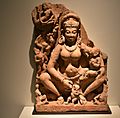Mother goddess facts for kids
A mother goddess is a special kind of goddess. She represents motherhood or the idea of fertility. Fertility means the ability to create new life. This includes plants growing, animals having babies, and humans being born.
Sometimes, these goddesses are called "mother earth" or "earth mother." They are often seen as the source of all life. This idea is sometimes paired with a "sky father." A sky father is a god who represents the sky. Often, the mother goddess is also the mother of other gods and goddesses.
Contents
What is a Mother Goddess?
A mother goddess is a powerful female deity. She is linked to the creation of life. She can represent the Earth itself. She brings forth plants, animals, and people. Many ancient cultures believed in a mother goddess. They saw her as the giver of life and a protector.
The Idea of Fertility
Fertility is a key part of a mother goddess's role. It means the power to produce new life. For early humans, this was very important. They relied on good harvests and healthy offspring. A mother goddess was believed to help with these things. She ensured that crops grew well. She also helped people and animals have babies.
Mother Earth and Sky Father
The idea of a "mother earth" is very old. She is the Earth itself, giving life to everything. Sometimes, she is paired with a "sky father." The sky father brings rain and light. Together, they represent the balance of nature. This balance helps life continue and grow.
Why Were Mother Goddesses Important?
Mother goddesses were very important in ancient societies. They were central to people's lives. They helped explain how the world worked. They also gave hope for good harvests and healthy families.
Connection to Nature
Many mother goddesses were closely linked to nature. They represented the cycles of the seasons. They were seen in the growth of plants and the flow of rivers. People believed they controlled the weather. They also influenced the success of farming. Worshipping them was a way to ask for nature's blessings.
Role in Creation
In many myths, a mother goddess is a creator. She might have created the world. She could also be the mother of other gods and goddesses. These stories show her power. They highlight her role in bringing everything into existence.
Examples of Mother Goddesses
Beliefs in mother goddesses appeared all over the world. Different cultures had their own names for them. But they often shared similar roles and meanings.
Ancient Mother Goddesses
One of the oldest known figures is from Çatalhöyük, Turkey. This statue is from about 8,000 BC. It shows a large female figure. She is often seen as an early mother goddess. She represents fertility and abundance.
In ancient Egypt, the goddess Isis was a powerful mother figure. She was known for her magic and healing. She protected her son, Horus. She was also seen as a mother to all pharaohs.
The goddess Demeter was worshipped in ancient Greece. She was the goddess of agriculture and harvest. She ensured that crops grew. Her daughter, Persephone, was also important. Demeter's stories are linked to the changing seasons.
Mother Goddesses Today
Some religions still honor figures similar to mother goddesses. In Hinduism, Durga is seen as a supreme mother goddess. She is powerful and protective. She fights evil and brings peace. Many Hindus worship her as a divine mother.
Images for kids
-
Mother Goddess sculpture from Madhya Pradesh or Rajasthan, India, 6th-7th century, in the National Museum of Korea, Seoul
-
Goddess Durga is seen as the supreme mother goddess by Hindus
See also
 In Spanish: Diosa madre para niños
In Spanish: Diosa madre para niños




